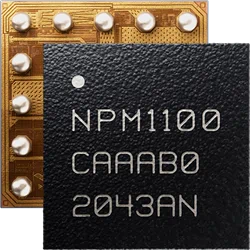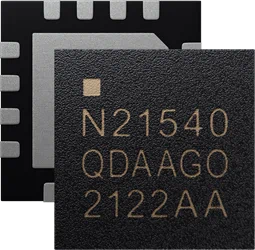nRF54H Series
Sampling to selected customers now
nRF54H20 wireless SoC
Sampling now: Revolutionary multiprotocol and multiprocessor SoC with world-leading processing power and efficiency, ample memory, record-breaking radio, and state-of-the-art security.
nRF54L Series
Widely available for development
Advanced Bluetooth Mesh SoCs
Four of the seven SoCs in the nRF52 Series support Bluetooth Mesh. All four integrate a powerful yet efficient 64 MHz Arm Cortex-M4 CPU. Flash memory size ranges from 256 KB to 1024 KB while RAM size ranges from 32 KB to 256 KB. The nRF52 Series offers simpler cost-effective options and highly advanced options, all with ultra-low power consumption. The nRF52 Series is truly the ideal platform for basing a product portfolio upon. The similar hardware and software architecture results in excellent software portability, increasing software reusability and lowering time-to-market and development cost.
The nRF5340 SoC is our Bluetooth Low Energy flagship. It is the world’s first wireless SoC with two Arm® Cortex®-M33 processors. The combination of two flexible processors, up to 105 °C operating temperature and advanced security features make it the perfect choice for Bluetooth Mesh applications such as professional lighting, sensor networks, and asset tracking. The nRF5340 is an all-in-one SoC, including a superset of the most prominent nRF52 Series features. Features like Bluetooth 5.4, high-speed SPI, QSPI, USB, and more, are combined with more performance, memory, and integration, while minimizing current consumption. It also offers security features such as trusted execution, root-of-trust, and secure key storage.
The nRF52 and nRF53 Series are all-flash based SoCs. Flash memory brings complete flexibility and upgradability to your products. They can be re-programmed in the factory or in the field with over-the-air device firmware upgrades (OTA DFU). This enables product updates and feature additions any time, anywhere.
nRF53 Series
nRF5340 SoC
Dual-core Bluetooth 5.4 SoC supporting Bluetooth Low Energy, Bluetooth mesh, NFC, Thread and Zigbee
128 MHz Arm Cortex-M33 CPU with
1 MB Flash + 512 KB RAM
64 MHz Arm Cortex-M33 CPU with
256 KB Flash + 64 KB RAM
Bluetooth Low Energy
Bluetooth Direction Finding
Bluetooth mesh
Thread, Zigbee
ANT
NFC
Advanced security
USB, QSPI, HS-SPI
105 °C extended operating temperature
1.7-5.5 V supply voltage range
nRF52 Series
Bluetooth Mesh SoCs comparison
| nRF5340 | nRF52840 |
nRF52833 | nRF52832 | |
|---|---|---|---|---|
| CPU | 128 MHz Arm Cortex-M33 + 64 MHz Arm Cortex-M33 |
64 MHz Arm Cortex-M4 with FPU | 64 MHz Arm Cortex-M4 with FPU | 64 MHz Arm Cortex-M4 with FPU |
| Flash | 1 MB + 256 KB |
1 MB | 512 KB | 512/256 KB |
| RAM | 512 KB + 64 KB |
256 KB | 128 KB | 64/32 KB |
| Arm TrustZone | Yes | Yes | ||
| Arm CryptoCell | 312 | 310 | ||
| Root-of-Trust | Yes | Yes | ||
| Secure key storage | Yes | |||
| High-Speed SPI | Yes | Yes | Yes | |
| TWI/SPI/UART | 4xTWI/SPI/UART +TWI/SPI/UART | 2xTWI/SPI, SPI, 2xUART | 2xTWI/SPI, SPI, 2xUART | 2xTWI/SPI, SPI, 2xUART |
| QSPI | Yes | Yes | ||
| USB | Yes | Yes | Yes | |
| PWM, PDM, I2S | Yes | Yes | Yes | Yes |
| ADC, Comparator | Yes | Yes | Yes | Yes |
| Operating temperature | -40 to 105 °C | -40 to 85 °C | -40 to 105 °C | -40 to 85 °C |
| Supply voltage range | 1.7 to 5.5 V | 1.7 to 5.5 V | 1.7 to 5.5 V | 1.7 to 3.6 V |
| Packages | 7x7 mm aQFN94 (48 GPIOs) 4.4x4.0 mm WLCSP95 (48 GPIOs) |
7x7 mm aQFN73 (48 GPIOs) 3.5x3.6 mm WLCSP94 (48 GPIOs) |
7x7 mm aQFN73 (42 GPIOs) 5x5 mm QFN40 (18 GPIOs) 3.2x3.2 mm WLCSP (42 GPIOs) |
6x6 mm QFN48 (32 GPIOs) 3.0x3.2 mm WLCSP50 (32 GPIOs) |
Compatible PMIC and RF FEM options
Concurrent Bluetooth Mesh and Bluetooth LE
All Bluetooth Mesh SoCs can run both Bluetooth Low Energy and Bluetooth Mesh concurrently. The radio time is time sliced and shared between the protocols. The scheduling is autonomous and connections are maintained. Leverage the interoperability of our Bluetooth LE stack and let a Bluetooth LE device, such as a smartphone, bridge into the Bluetooth Mesh network. The smartphone can then provision/commission in new nodes and interact with the mesh network.
.png)














